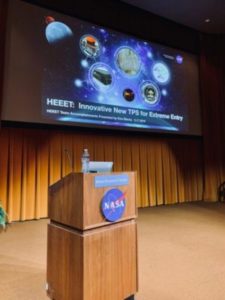“I think some of the NASA approach and mindset started to rub off on us, and we started to push what we could do even further into other projects.”
—
Bally Ribbon Mills’ Mark Harries recently spoke at NASA’s Ames Research Center in celebration of the Heatshield for Extreme Entry Environment Technology team of NASA and BRM scientists and their exceptional accomplishments over the last ten years. His remarks offer a helpful lens for understanding BRM’s dedication to innovation:

“The first meeting I ever attended with [NASA Ames Research Center engineer] Raj Venkatapathy and the Ames group was in 2010. I remember this meeting well, and tried to think about why this meeting stood out in my mind—I had been to many customer visits and sales calls—and I finally figured out what made this one so special. It was the extraordinary level of excitement and energy surrounding the whole meeting. From beginning to end, our engineers and the NASA engineers exchanged ideas. We realized, even at that early stage, that we had both found a great partner. The Ames group was excited because of our capabilities and past experience with complex highly technical weaving, and we were excited to embark on developing new technologies and ideas that had never been developed before, including finished parts, weaving techniques, and a new loom.
That first meeting went well, and honestly, the meetings kept going well. Here we are almost ten years later celebrating the HEEET program. And what an exciting 10 years it has been. We’ve learned a great deal about woven thermal protection systems (TPS) since the start.
There has been a lot of learning. We had made panels and 3D weaves before, and I think that’s what generated the initial interest in our company, but what the Ames group was asking for with the HEEET program went above and beyond anything else in our experience to that time.
The scale of everything was bigger than anything we had attempted up until that point. The loom was bigger. The amount of yarn and number of ends (or yarn per inch of material) was incredible. For example, the first iteration had a total of 25,000 ends to weave and interconnect and keep consistent tensions with. So, the loom needed to be specially designed to handle the complex and dense material. The loom is one of a kind in the world. And because science doesn’t stop at just good enough… we got even more complex. On the most current revision of HEEET, we weave 36,000 ends. It has two main parts, one for recession and the other for insulation and protection. On both sides, NASA and the Bally Ribbon Mills teams tackled each hurdle and ultimately were successful.
There were ups and downs and some big challenges. And we are so happy that we tackled those problems. After each issue, whether related to yarn, machinery and equipment, or programming, we learned and catalogued and anticipated the next course of action. I think some of the NASA approach and mindset started to rub off on us, and we started to push what we could do even further into other projects. For me, as a small business owner, this is the most valuable result of our partnership with NASA. We pushed ourselves. We made things that we would have never been able to otherwise and as a result of that partnership, we are seeing great returns on that investment, because these products aren’t just useful for one application. There are commercial and government entities buying products as a direct result of our work and the advancement of our capabilities.
Our history with NASA is a long one. We’ve made parts for many missions including webbing for the deceleration systems on the mars rovers. When [Former astronaut and NASA Administrator] Charlie Bolden was at BRM in 2015, he gave us a terrific tag line: “the path to Mars goes through Bally, Pennsylvania.” And with HEEET, we want it to come back again too with the Mars Sample Return Mission!”
For more information about BRM’s work on the NASA HEEET Program, click here.






